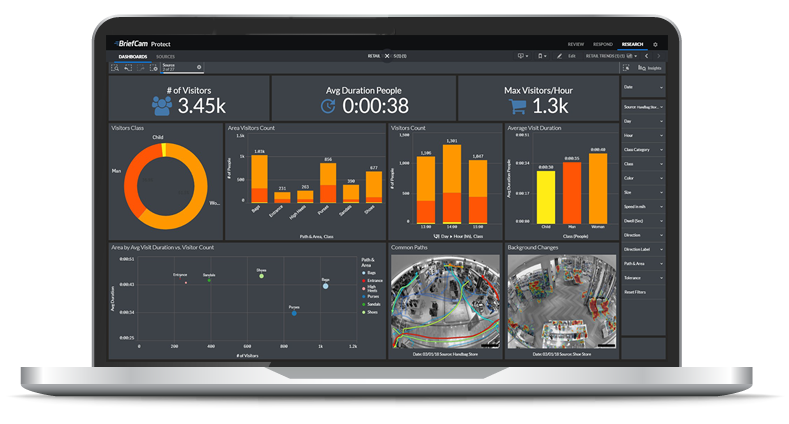What is Video Intelligence Software?

What is Video Content Analytics and How Can It be Used?
Organizations with growing security challenges are now looking to video surveillance to overcome both security and operational inefficiencies. Video content analytics software is an artificial intelligence backed technology solution that offers a broad spectrum of analytic capabilities to enhance video security systems, enabling operators to leverage existing video surveillance investments to:
- Search and filter through overwhelming quantities of security footage for actionable information
- Trigger real-time alerts to increase situational awareness and drive faster response time as threats or emergencies develop
- Quantify video data and leverage metrics for planning, development, and operations optimization
By integrating video content analysis software, organizations can extend the value derived from traditional security footage and flexibly and seamlessly scale operations based on a data-driven approach.
How Video Intelligence Software Works
Intelligent video analysis relies on Deep Learning and artificial intelligence technologies to drive:
- Object Extraction: artificial intelligence isolates a specific object that appears in the video
- Object Identification: the system compares the system is trained using Deep Learning techniques to identify the extracted object
- Object Classification: finally, the system compares the object to known objects stored in a comprehensive internal database to categorize and catalogue the object
This Deep Learning-driven process involves training the system to recognize and match objects, which is achieved by exposing the system to massive sets of tagged images. For instance, to teach a machine how to recognize a girl, the system must be exposed to thousands of tagged images of girls (and images without girls) so that future images of girls can be accurately identified. Of course, when trained effectively, Deep Neural Networks (DNNs) can not only distinguish based on gender, but can also recognize types of vehicles or animals and even drive activities, such as face recognition, i.e. identifying matches for specific individuals.
Once a video analytics engine processes video using these techniques, all of the extracted and identified objects are indexed as metadata so that video content can be searched; real-time alerts can be configured based on identifiable objects or behaviors; and data can be aggregated over time to generate business intelligence dashboards and reports.
How Video Content Analytics Helps End Users
Video surveillance is nearly ubiquitous, but the vast majority of the content captured is never used. The overwhelming quantities of recorded and live footage are far too vast for humans to efficiently and effectively search and review manually. Video content analytics empowers users to utilize this video without investing significant time and manpower. By making video easily searchable, actionable and quantifiable, resources can be reallocated for more critical activities, video surveillance content can be actively utilized and organizations can share video data traditionally used only for security for maximizing efficiency across business groups. Here are a few examples of how video content analytics can serve a variety of stakeholders within diverse organization types.
Video Analysis Software in Action
- Video Content Analytics for Retail
Video content analytics, like video surveillance, has innumerable use cases for retail security and loss prevention. But this is just the beginning. By identifying demographic data, inefficiencies with store navigation and product placement and problem hotspots within the store, video content analytics can drive optimized merchandising decisions, store layout- and, ultimately, profits by leveraging actionable intelligence about customer traffic patterns, object interactions and demographic segmentations.
- Video Intelligence Software for Transportation
Video intelligence software is being used to optimize traffic flows and manage crowd control for more efficient and safe transportation inside facilities, on city streets, and in public areas. For instance, a leading university in the United States leveraged video analytics to derive information about daily traffic patterns, peaks, and violations – as well as data about intersections and vehicle types – to understand activity, identify problem hotspots and make informed decisions about updating traffic infrastructure and optimizing traffic flows based on actionable data. Transport and traffic insights delivered by video intelligence are critical for transit providers, transport terminals and travelers and facilitate streamlined movement, regardless of the method of transportation.
- Video Investigation Software for Law Enforcement
Of course, these capabilities have massive implications for law enforcement and investigation. Police use video investigation software to:
- Search for, pinpoint and track persons of interest across multiple cameras and videos
- Identify otherwise overlooked evidence, such as details invisible to the human eye
- Enhance post-event investigations to solve cases more quickly
- Increase situational awareness and accelerate responses to emergencies and threats
Conclusion
Like any game-changing information technology, video analytics is helping organizations do things that mere surveillance never could. From retailers to law enforcement professionals, city planners and transit agencies, and beyond, organizations are empowered to maximize existing video asset investments, transforming everyday video surveillance into actionable intelligence for security and beyond.
Signup to receive a monthly blog digest.